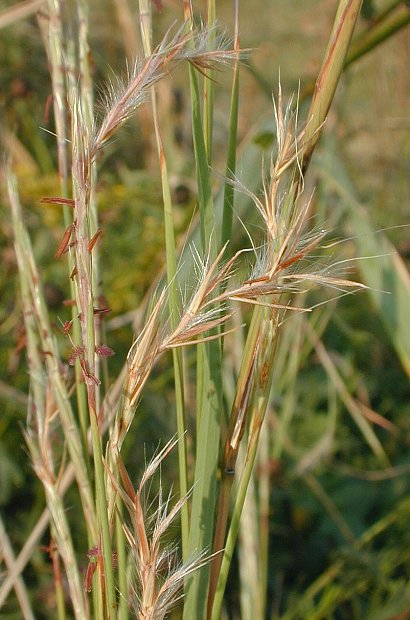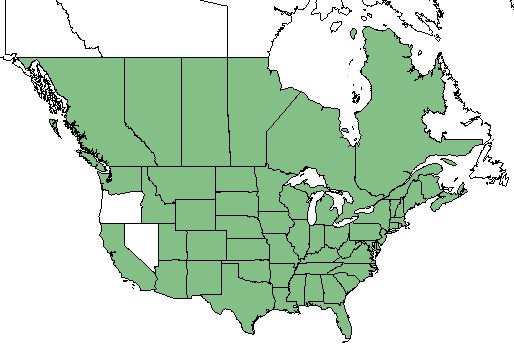Difference between revisions of "Schizachyrium scoparium"
(→Distribution) |
|||
| Line 31: | Line 31: | ||
==Ecology== | ==Ecology== | ||
===Habitat=== <!--Natural communities, human disturbed habitats, topography, hydrology, soils, light, fire regime requirements for removal of competition, etc.--> | ===Habitat=== <!--Natural communities, human disturbed habitats, topography, hydrology, soils, light, fire regime requirements for removal of competition, etc.--> | ||
| − | < | + | ''S. scoparium'' proliferates in various open habitats, in a wide range of moist to dry habitats, fall-line sandhills in the inner Coastal Plain, perhaps in other dry habitats. <ref name= "Weakley 2015"> Weakley, A. S. (2015). Flora of the Southern and Mid-Atlantic States. Chapel Hill, NC, University of North Carolina Herbarium. </ref> |
| + | ===Phenology=== <!--Timing off flowering, fruiting, seed dispersal, and environmental triggers. Cite PanFlora website if appropriate: http://www.gilnelson.com/PanFlora/ --> | ||
| + | ''S. scoparium'' flowers in November. <ref name= "PanFlora"> PanFlora Author: Gil Nelson URL: [http://www.gilnelson.com/PanFlora/ http://www.gilnelson.com/PanFlora/] Date Accessed: 5/29/18 </ref> | ||
<!--===Seed dispersal===--> | <!--===Seed dispersal===--> | ||
<!--===Seed bank and germination===--> | <!--===Seed bank and germination===--> | ||
| − | + | ===Fire ecology=== <!--Fire tolerance, fire dependence, adaptive fire responses--> | |
| + | ''S. scoparium'' is not fire resistant, but has medium fire tolerance. <ref name= "USDA Plant Database"/> | ||
<!--===Pollination===--> | <!--===Pollination===--> | ||
| − | + | ===Use by animals=== <!--Herbivory, granivory, insect hosting, etc.--> | |
| + | ''S. scoparium'' has medium palatability for browsing animals and high palatability for grazing animals. <ref name= "USDA Plant Database"/> | ||
<!--==Diseases and parasites==--> | <!--==Diseases and parasites==--> | ||
Revision as of 14:56, 29 May 2018
| Schizachyrium scoparium | |
|---|---|

| |
| Photo by John Hilty hosted at IllinoisWildflowers.info | |
| Scientific classification | |
| Kingdom: | Plantae |
| Division: | Magnoliophyta - Flowering plants |
| Class: | Liliopsida - Moncots |
| Order: | Poales |
| Family: | Poaceae |
| Genus: | Schizachyrium |
| Species: | S. scoparium |
| Binomial name | |
| Schizachyrium scoparium (Michx.) Nash | |

| |
| Natural range of Schizachyrium scoparium from USDA NRCS Plants Database. | |
Contents
Taxonomic Notes
Synonyms: (for var. divergens) Andropogon scoparius Michaux var. divergens Hackel; Andropogon divergens; (for var. scoparium) S. scoparium; S. scoparium ssp. scoparium; (for var. stoloniferum) S. stoloniferum Nash; Andropogon stolonifer (Nash) A.S. Hitchcock
Varieties: Schizachyrium scoparium (Michaux) Nash var. divergens (Hackel) Gould; Schizachyrium scoparium (Michaux) Nash var. scoparium; Schizachyrium scoparium (Michaux) Nash var. stoloniferum (Nash) J. Wipff
Description
S. scoparium is a perennial graminoid of the Poaceae family native to North America and Canada and introduced to Hawaii. [1]
Distribution
S. scoparium is found: everywhere in the United States excluding Oregon and Nevada; every region in Canada; every island in Hawaii. [1]
Ecology
Habitat
S. scoparium proliferates in various open habitats, in a wide range of moist to dry habitats, fall-line sandhills in the inner Coastal Plain, perhaps in other dry habitats. [2]
Phenology
S. scoparium flowers in November. [3]
Fire ecology
S. scoparium is not fire resistant, but has medium fire tolerance. [1]
Use by animals
S. scoparium has medium palatability for browsing animals and high palatability for grazing animals. [1]
Conservation and Management
Cultivation and restoration
Photo Gallery
References and notes
- ↑ 1.0 1.1 1.2 1.3 USDA Plant Database https://plants.usda.gov/core/profile?symbol=SCSC
- ↑ Weakley, A. S. (2015). Flora of the Southern and Mid-Atlantic States. Chapel Hill, NC, University of North Carolina Herbarium.
- ↑ PanFlora Author: Gil Nelson URL: http://www.gilnelson.com/PanFlora/ Date Accessed: 5/29/18